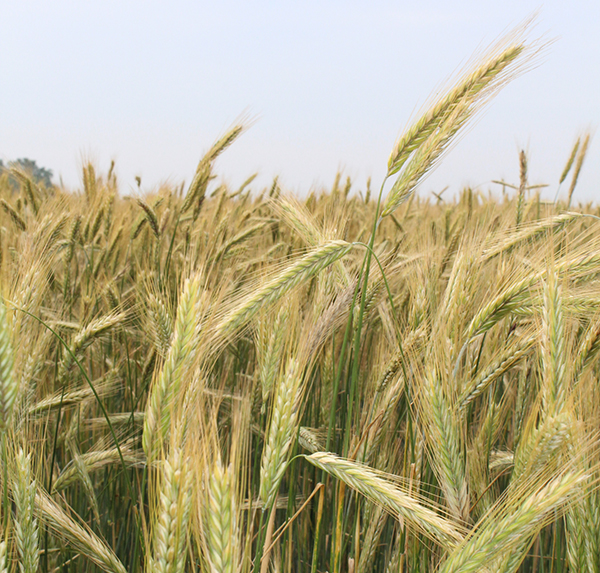Fertility Management for Hybrid Rye
by Margaret Smith, PhD Agronomist
Hybrid rye is our highest-yielding small grain, but it requires adequate fertility to reach its potential. Fertility, particularly nitrogen, management for hybrid winter rye differs somewhat from that for winter wheat and from that for open-pollinated rye planted for grain harvest.
Hybrid winter rye in the last three years has been yielding from 80 to 120 bu/A on Upper Midwestern farms. (test weight per bushel is 56 lbs.) Yields in University variety trials tend somewhat higher, with hybrid outyielding open-pollinated ryes by 50 to 100%, depending on varieties.
Rye is often touted as performing well on poor soils and with low pH and fertility, but this is misleading. Rye does perform better than wheat, barley, or oats in poorer soil conditions, but performs best on good, well-drained soils and with adequate fertility.
Nitrogen
Rate
Nitrogen (N) requirement is 1.2 lbs N per bushel of hybrid rye grain. Apply N credits for soybeans, forage and cover crop legumes, and manure as you would for corn before calculating additional N fertility needs.
Crop Uptake Timing
Nitrogen uptake occurs both in the fall and the spring. The rate of uptake is greatest during tillering (spring and fall) and begins to decline in the spring after stems belong to elongate, although N uptake continues through grain fill.
Application Timing
Split N applications provide the best management for optimum hybrid rye yields. Apply 40 lbs N in the fall, with the remainder applied in the spring. Unlike with wheat, apply spring N only while the rye is still vegetative—before stem elongation begins. Applying later may miss the timing of maximum uptake and damage the developing stems, which will delay pollination. Delaying pollination can lead to a much higher incidence of ergot infection. Without crop disturbance at reproductive stages, hybrid rye pollinates in a very uniform timeframe.
Poorly drained areas or those with heavy soils, where conditions are consistently wet in the spring may limit machinery traffic for spring N applications. In these situations, apply all N fertilizer for winter rye in the fall.
Minnesotans, check whether or not you are in a fall N restricted zone before applying more than 40 lbs N as rye grass fertilizer in the fall.
Form
If using manure as your N source, apply all in the fall and incorporate before hybrid rye planting. Although the ammonium fraction of manure N is rapidly available, the organic form of N is slowly released and needs to interact with soil microbes both in the fall and very early spring, to ensure adequate mineralization and release.
Best manufactured N sources for fall application include MAP, DAP, ATS (ammonium thiosulfate), UAN, and urea.
For spring applications, avoid UAN over the top of rye due to the potential to damage growing leaves. Avoid urea applications on frozen soil in the spring, but it can be used after soils have thawed. Also avoid using ESN (polymer-coated urea) in the spring, as nitrogen release may be too slow for plant availability early in the season.
Phosphorus and Potassium
Crop removal rates per bushel of hybrid rye are somewhat lower for phosphorus (P) and comparable for potassium (K) removal per bushel of winter wheat. Because hybrid rye yields more than winter wheat, total P and K winter rye fertilizer requirements per acre will be greater.
Rye grain removes 0.187 lbs of P and 0.256 lbs of K per bushel of yield. Additional K is recommended to support the vegetative growth of the crop. Suggested P and K rates are 25 lbs/A P and 40-50 lbs/A K. Rates should be increased for soils testing lower that in the optimal range. For rate adjustments based on soil test levels and yield goals, see the University of Minnesota Rye Fertilizer Recommendations.
Resources
- University of Minnesota Extension: Minnesota’s nitrogen fertilizer application restrictions begin this fall. Here’s what you should know
- Minnesota Department of Agriculture: Nitrogen Fertilization Best Management Practices for Agricultural Lands in Minnesota
- University of Minnesota Extension: Rye Fertilizer Recommendations
